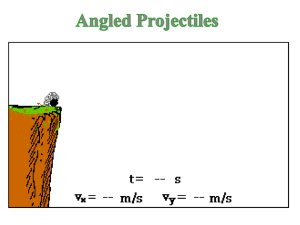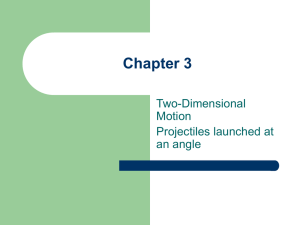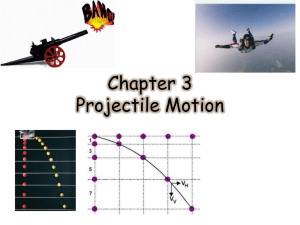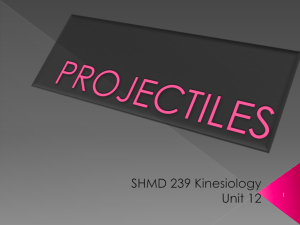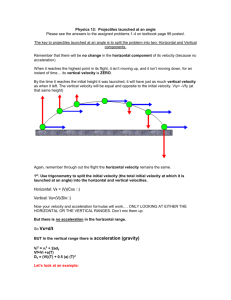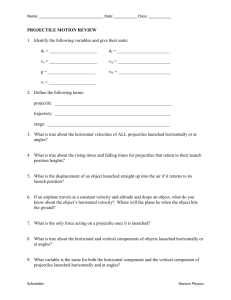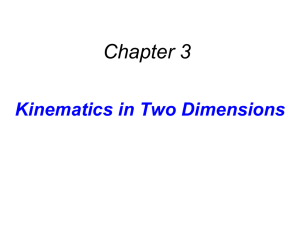Projectile Motion Power Point
advertisement
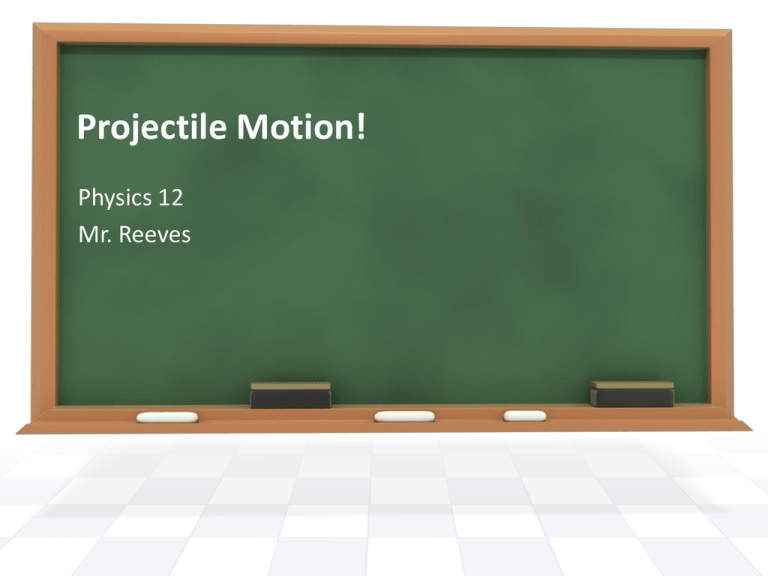
Projectile Motion! Physics 12 Mr. Reeves •Velocity Components Review • • A projectiles total velocity is composed of how many components? What are these components? Vertical (Y) Velocity Total Velocity Horizontal (X) Velocity •Angry Birds!! They’re angry. And following the laws of Physics! •Today’s Objectives: 1 Review components of an objects velocity 2 Introduce the formula for projectile motion 3 Using the formula, students will be able to solve a projectile motion problem when given initial conditions. •The motion of an object can be explained using this formula: PROJECTILE MOTION: • D = Vi * t + (1/2) *a * t^2 • D = displacement Vi = Initial velocity t = Time of travel a = acceleration • • • • *Remember, this formula can be applied to both horizontal and vertical components! •Steps to solving a projectile motion problem Step 1 •Make sure to label units for each value. • Record all known values from the problem Step 2 •The better your booking keeping is, the easier your calculations will be! • Use the vertical components to calculate the time the ball will be in the air Step 3 • Use the time and the horizontal components to calculate the distance the ball will travel •Lets review projectile motion! • The boy on the tower throws a ball a distance of 20m. At what speed is the ball thrown? •Solution: First let’s list our known values. Horizontal Information • Dx = 20m • vix = ??? • ax = 0 m/s/s • Vertical Information Dy = 4.9m viy = 0 m/s ay = 9.8 m/s/s •We can use the vertical components of the ball’s motion to determine the time it will travel. Dy = Viy*t+(1/2)Ay*t^2 4.9m = (0 m/s)•t + 0.5•(9.8 m/s/s)•t2 4.9m = (4.9 m/s/s)•t2 1 s2 = t 2 t=1s We now use the time which we calculated and our horizontal components to calculate the initial velocity. Dx = Vix*t+(1/2)Ax*t^2 20m = (Vix)•(1s) + 0.5•(0 m/s/s)•(1s)2 20m = (Vix)•(1s) Vix= 20m/1s = 20m/s •Lets try another! • • A pool ball leaves a 0.60meter high table with an initial horizontal velocity of 2.4 m/s. Predict the time required for the pool ball to fall to the ground and the horizontal distance between the table's edge and the ball's landing location. •Solution: First let’s list our known values. Horizontal Information • Dx = ??? • vix = 2.4 m/s • ax = 0 m/s/s Vertical Information Dy = 0.60 m viy = 0 m/s ay = 9.8 m/s/s • 2.4 m/s | .6m | <---???---> 9.8m/s/s •We can use our vertical components to find time! Dy = Viy*t+(1/2)Ay*t^2 0.60 m = (0 m/s)•t + 0.5•(9.8 m/s/s)•t2 0.60 m = (4.9 m/s/s)•t2 0.122 s2 = t2 t = 0.350 s Now we can use our horizontal components to determine where the ball will land. Dx = Vix*t+(1/2)Ax*t^2 Dx = (2.4 m/s)•(0.3499 s) + 0.5•(0 m/s/s)•(0.3499 s)2 Dx = (2.4 m/s)•(0.3499 s) Dx = 0.84 m •Theory At the instant a horizontally held rifle is fired, a bullet held at the rifle’s side is released and drops to the ground. Which bullet strikes the ground first? http://www.youtube.com/watch?v=D9wQVIEdKh8 •Before you leave! On a separate paper answer these questions: •Does the time of travel for a projectile depend on the horizontal components or vertical components of its motion? How about the distance it travels? •What is one thing about today’s lesson that you still have questions about? If there is nothing, what is one thing you learned today? Have a good day!

